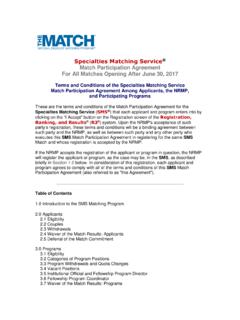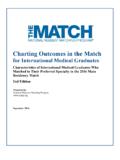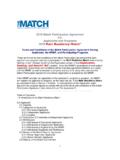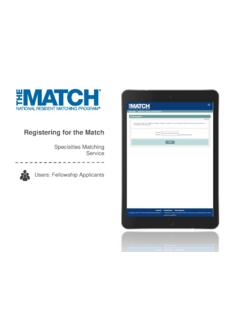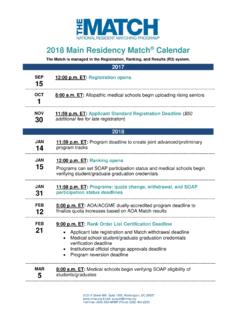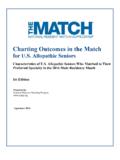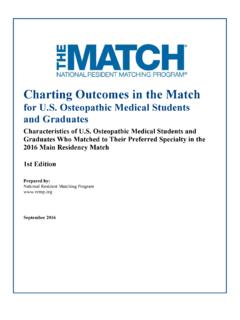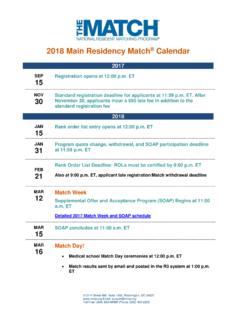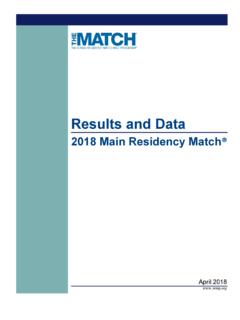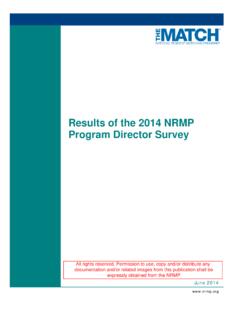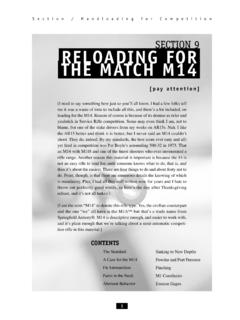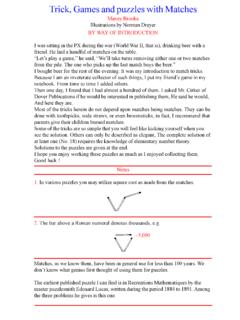Transcription of Charting Outcomes in the Match - nrmp.org
1 Charting Outcomes in the Match Characteristics of Applicants Who Matched to Their Preferred Specialty in the 2014 Main Residency Match 5th Edition Prepared by: National Resident Matching Program August 2014. Questions about the contents of this publication may be directed to Mei Liang, Director of Research, National Resident Matching Program, (202) 400-2233 or Questions about the nrmp should be directed to Mona M. Signer, Executive Director, National Resident Matching Program, (202) 400-2233 or Copyright 2014 National Resident Matching Program, 2121 K Street, NW, Suite 1000, Washington, DC 20037 USA. All rights reserved. Permission to use, copy and/or distribute any documentation and/or related images from this publication shall be expressly obtained from the nrmp . National Resident Matching Program, Charting Outcomes in the Match , 2014. National Resident Matching Program, Washington, DC 2014.
2 2014 Table of Contents Introduction .. ii Tables and Charts for All Specialties Chart 1. Active Applicants in the 2014 Main Residency Match ..2. Table 1. Number of Applicants and Positions in the 2014 Main Residency Match ..3. Chart 2. Ratio of Applicants Ranking Specialty First / Available Positions ..4. Chart 3. Match Rates ..5. Table 2. Summary Statistics ..6. Chart 4. Median Number of Contiguous Ranks ..7. Chart 5. Mean Number of Different Specialties Ranked ..8. Chart 6. USMLE Step 1 Scores of Matched Applicants ..9. Chart 7. USMLE Step 2 Scores of Matched Applicants ..10. Chart 8. Mean Number of Research Chart 9. Mean Number of Abstracts, Presentations, and Publications ..12. Chart 10. Mean Number of Work Experiences ..13. Chart 11. Mean Number of Volunteer Experiences ..14. Chart 12. Percentage of Allopathic Seniors Who are Members of AOA ..15. Chart 13. Percentage of Allopathic Seniors Graduating from One of the 40 Medical Schools with the Highest NIH Funding.
3 16. Chart 14. Percentage of Matched Allopathic Seniors Who Have a Graduate Degree ..17. Tables and Charts for Individual Specialties Anesthesiology ..18. Child Neurology ..31. Dermatology ..44. Diagnostic Radiology ..57. Emergency Medicine ..70. Family Medicine ..83. General Surgery ..96. Internal Medicine ..109. Internal Medicine/Pediatrics ..122. Neurological Surgery ..135. Neurology ..148. Obstetrics and Gynecology ..161. Orthopaedic Surgery ..174. Otolaryngology ..187. Pathology ..200. Pediatrics ..213. Physical Medicine and Rehabilitation ..226. Plastic Surgery ..239. Psychiatry ..252. Radiation Oncology ..265. Vascular Surgery ..278. Copyright 2014 nrmp . Reproduction prohibited without the i Charting Outcomes in the Match , 2014. written permission of the nrmp . 2014 Introduction Background The first edition of Charting Outcomes in the Match was published in August 2006 to document how applicant qualifications affect success in the Main Residency Match .
4 The report was published biennially between 2007 and 2011. Prior to 2014, Charting Outcomes in the Match was a collaborative publication of the National Resident Matching Program ( nrmp ). and the Association of American Medical Colleges (AAMC ). Match outcome data from the nrmp were combined with applicant characteristics from the AAMC's Electronic Residency Application Service (ERAS ) and USMLE scores from the AAMC data warehouse. However, starting with the 2014 Main Residency Match , the nrmp added a Professional Profile section to its Match registration process and was able to collect USMLE scores and other applicant characteristics used to produce this report. Thus, this fifth edition of Charting Outcomes in the Match is being published independently by the nrmp . Data Match success, specialty preference, and ranking information were collected through nrmp Match operations.
5 The 40 medical schools receiving the highest totals of National Institutes of Health (NIH) grants were obtained from the NIH website. There were no missing data observed for these fields. Other applicant characteristics, including USMLE Step 1 and Step 2 scores, academic degrees, publications, Alpha Omega Alpha Honor Medical Society (AOA) membership, and research, work and volunteer experiences, were self-reported through the Professional Profile section of the nrmp 's Applicant Registration Form for the Match . To complete the form, applicants were asked to answer the questions as they did in their ERAS Common Application Form (CAF). To ensure that USMLE Step scores were not misreported, the nrmp asked medical schools to verify scores of their senior students. About 75 percent of the self-reported Step 1 scores and 71 percent of the Step 2 scores provided by seniors were verified or corrected.
6 Because there were no significant differences between the self-reported scores and school-verified scores (p= for Step 1 scores, p= for Step 2 scores), verified and unverified scores were used to prepare this report. Data collection for the self-reported Professional Profile section was approved and overseen by the American Institutes for Research (AIR). Institutional Review Board (IRB). Data provided in that section were excluded from this report if the applicant did not give consent to participate in nrmp research (about 5% seniors and 7% of independent applicants). Methods Specialties that offered 50 or more positions in the 2014 Main Residency Match are included in these reports. Over the years, new specialties have been added, including Otolaryngology and Neurology in 2007, Neurological Surgery in 2009, and Child Neurology and Vascular Surgery in 2014. Transitional Year programs were excluded from the 2011 and 2014 reports because they are not viewed as a specialty choice.
7 Twelve measures are incorporated in this report. Probability analysis using a simple logistic regression model was introduced in 2009 to evaluate the relationship between Match success and contiguous ranks and USMLE Step 1 scores. It is important to note that for purposes of this report, Match success is defined as a Match to the specialty of the applicant's first-ranked program, or "preferred specialty," because that is assumed to be the specialty of choice. Lack of success includes matching to another specialty as well as failure to Match at all. No distinction was made based on whether applicants matched to the first, second, third, or last choice program. Because graduating seniors from allopathic medical schools Match at higher rates than do other applicant groups, and because some of those groups contain small numbers of applicants, this report distinguishes only two types of applicants: seniors and independent applicants.
8 Independent applicants include all applicant types other than seniors: citizen and citizen students/graduates of international medical schools, students/graduates of osteopathic medical schools, previous graduates of allopathic medical schools, students/graduates of Fifth Pathway programs, and students/graduates of Canadian medical schools. It should be noted that the independent applicant category is a heterogeneous group. Moreover, because independent applicants Match to their preferred specialties at much lower rates than do seniors, the specialty-specific probability graphs for independent applicants are less predictive of success. Copyright 2014 nrmp . Reproduction prohibited without the ii Charting Outcomes in the Match , 2014. written permission of the nrmp . 2014 Introduction (continued). Summary Some general observations apply to all specialties in this report. Applicants who are successful in matching to their preferred specialty are more likely to: Rank more programs within their preferred specialty Be allopathic medical school seniors Have higher USMLE Step 1 and Step 2 scores Be members of Alpha Omega Alpha Although some other measures seem to be related to Match success for some specialties, the relationships are not consistent enough to draw broad conclusions across specialties.
9 In addition, the data sources used for Charting Outcomes in the Match do not include other important applicant factors such as course evaluations, reference letters, and the Medical School Performance Evaluation (MSPE). Despite the fairly strong relationship between USMLE Step scores and Match success, the distributions of scores show that program directors consider other qualifications. A high score is not a guarantee of success, and a lower score is not a bar to success. Even in the most competitive specialties a few individuals with higher scores are not successful. In the less competitive specialties, seniors with scores slightly above passing usually Match to their preferred specialties. The data also are reassuring because they indicate that at least some programs do not employ an arbitrary cutoff or decline to consider applicants with less than excellent test performance.
10 The data in this report support the following straightforward advice one should give to an applicant: Rank all of the programs you really want, without regard to your estimate of your chances with those programs. Include a mix of both highly competitive and less competitive programs within your preferred specialty. Include all of the programs on your list where the program has expressed an interest in you and where you would accept a position. If you are applying to a competitive specialty and you want to have a residency position in the event you are unsuccessful in matching to a program in your preferred specialty, also rank your most preferred programs in an alternate specialty. Include all of your qualifications in your application, but know that you do not have to be AOA, have the highest USMLE scores, have publications, or have participated in research projects to Match successfully.
